Depictions of the Great Wall of China in Art
From the moment in 1976 that Serbian and German performance artists Marina Abramović and Ulay (Frank Uwe Laysiepen, who died terminal month anile 76) clapped eyes on each other they were inseparable. Ulay plant Abramović witchy and otherworldly; she found him wild and exciting. Even their initial encounter was propitious: they met in Amsterdam on their shared birthday of xxx November.
The pair began to perform together, describing themselves as a "two-headed body". For years they lived a nomadic lifestyle, travelling across Europe in a corrugated iron van and performing in villages and towns. Their artistic collaborations matched their personalities: they focused on performances that put them in precarious and physically enervating situations, to see how they and their audition would respond. In one, called Relation in Time, they remained tied together by their hair for 17 hours. They explored conflict, taking their ideas to extremes: running total pelt into each other, naked, and slapping each other's faces until they could have no more than.
1 of their pieces, Residuum Energy, performed in Dublin in 1980, saw them balance each other on opposite sides of a drawn bow and arrow, with the arrow pointed at Abramović's middle; i slip from Ulay and he could take killed her. Uncomfortable viewing, this was human relationship therapy played out equally art – and, mayhap, vice versa.
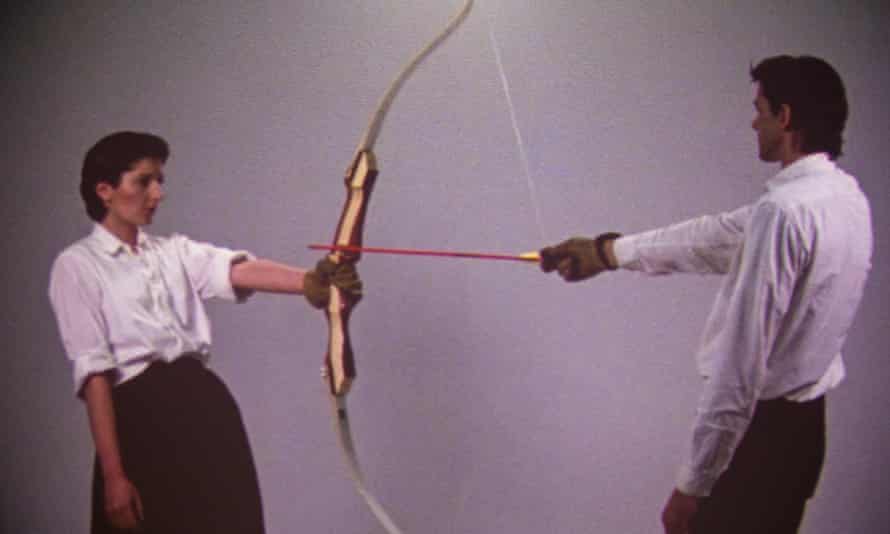
In 1983, Abramović and Ulay announced their ultimate collaboration: The Lovers. They proposed to be the first people to walk the Corking Wall of People's republic of china. Setting off solitary from opposite ends, they planned to meet in the middle, where they would marry. Exhilarated by the emotional and physical scale of The Lovers, the pair imagined themselves walking alone across great expanses of the Chinese landscape, camping under the stars and concluding the journey with the ultimate commitment. They saw The Lovers as an odyssey and a performance in which they alone would be both players and audience.
Eager to gear up, and ever-practical, Ulay laid in a year'south supply of dried tofu and seaweed, together with tents and camping stoves. What the pair were less prepared for, however, was Chinese bureaucracy. The Beijing regime struggled to cover the pair's motives for the journey. No one camped or walked the Slap-up Wall every bit an "art projection". And who in their correct minds would want to get married on it? Newspaper trails were endless. Permissions and visas were granted then denied. The pair were told that it would be as well dangerous to practise the walk lonely and they would be required to have an accompanying crew. As phone calls, letters and documents were fired dorsum and forth betwixt China and the artists, years rolled past.
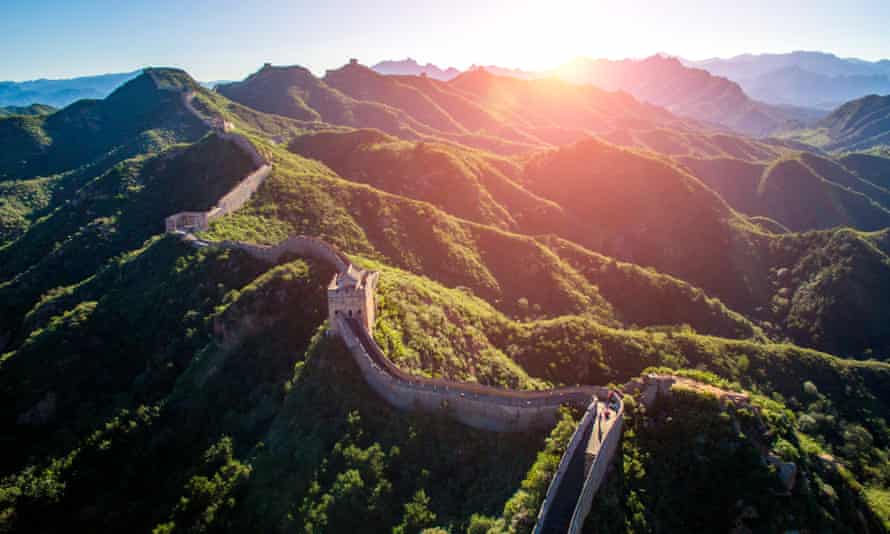
Photograph: Real444/Getty Images
In 1986, they went to Cathay to visit parts of the Not bad Wall, to familiarise themselves with it and encounter some of the villagers they would be staying with. Permission was finally granted for the walk to accept place the post-obit yr. Then, inexplicably, the authorities postponed information technology again. A frustrated Ulay confessed: "I have been living with the wall in my thoughts for 5 years. Already I feel I have walked it x times. Already it is worn, information technology is polished."
Finally, having too agreed to participate in a film of their "study" of The Dandy Wall for Chinese Central Idiot box, they were granted permission.
Abramović and Ulay began their walks on 30 March 1988, from either finish of the Not bad Wall, known to the Chinese equally The Sleeping Dragon. Abramović, set off westwards from the dragon'due south caput at the Bohai Bounding main, an extension of the Yellowish Sea between China and the Korean peninsula. Dressed in baggy blood-red clothes, she was given the nickname Pa Ma Ta Je – big fat sister mother.
Much of her trek proved arduous. Abramović was walking through the mountainous regions of eastern Cathay. On such hard and inaccessible terrain, she had to watch every footstep. On her fourth day, afterwards slipping on rocks as glace as polished ice, Abramović and her guide found themselves hanging by their fingertips over an abyss. She plant homes and stables built into sections of the winding wall, and other parts that had been dismantled past locals who, under Mao'south encouragement to "kill the dragon", had removed the clay and stones to build with. Once, Abramović claimed to have walked through a kilometre of human bones. Her adaptation in villages and hostels each nighttime was often a 2-60 minutes expedition from the wall.
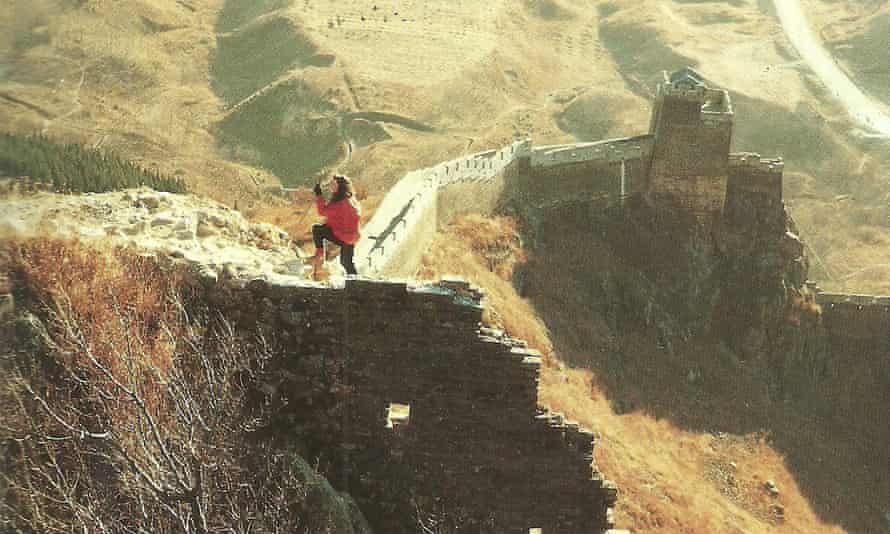
At every hamlet she stayed in, Abramović asked to come across its oldest resident and for them to share a local legend. Inevitably these were dragon stories, often related to the wall itself. While built more than a 1,000 years as a defense force confronting invaders from the north and west, the serpentine spine of the Peachy Wall had been carefully mapped out by geomancers for its "dragon energy". Abramović would occasionally find copper pots placed along the wall, as energy spots: acupuncture points to control the forces that rippled upwards and down the creature's back.
Five grand kilometres w of Abramović, Ulay had started his walk at the dragon'south tail in the Gobi Desert. Moustachioed and lean, with long hair and matching bright-blue drawstring trousers and greatcoat, Ulay would have looked to a westerner every bit the maverick traveller. Most of his journey would be spent trekking through China's deserts. Rickshaws and donkeys were familiar sights, as were camels pulling ploughs. Ulay crossed the great Yellowish River on a raft covered with sheepskins and, like Abramović, saw families living in caves within the wall itself. He managed to sleep under the stars some nights, while his bemused crew watched over him from their jeeps. Most of the time, however, Ulay also had to sleep in nearby villages. While the simplicity of the trek stirred Ulay'south soul, its fragmentation by bureaucracy and restrictions meant it was non the romantic sojourn the pair had dreamed of.
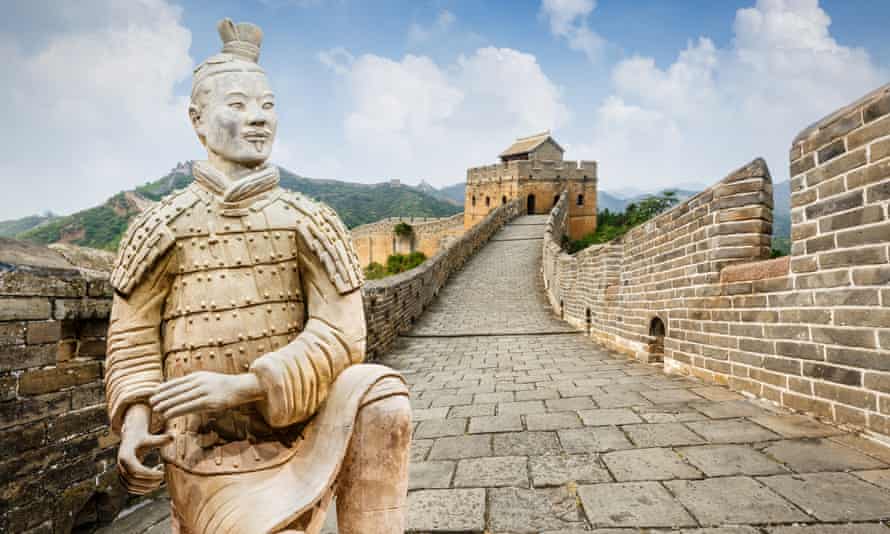
To the Chinese who encountered the artists, they were of great curiosity. Having originally believed themselves to be the sole players and audience for their walk, they constitute everything they did was witnessed as if a performance. In towns and villages, silent crowds followed them wherever they went. In one settlement, villagers gathered to watch Abramović sleep. When she awoke, a dissimilar group were nowadays, silently observing her.
More past happenstance than planning, Ulay and Abramović met at the heart of a rock bridge in Shenmu in Shaanxi province, among a series of temples built in the Ming dynasty. They had averaged 20km a day, walked 90 days and covered roughly 2,000km each. As they embraced affectionately, Ulay shared with Abramović his desire to proceed the walk "forever". Abramović was unequivocal in her want to get home. Ulay fabricated a comment almost her shoes that seemed to annoy her; to his irritation she began to cry.
While musicians, the Chinese printing and even a fireworks brandish had been laid on for the pair, at that place would be no wedding anniversary. Later a press conference in Beijing, they returned separately to Amsterdam and didn't speak or see one another for 22 years. What had gone wrong?

In the five years that Ulay and Abramović had been waiting for permission for the walk, their lives had changed irrevocably. Their piece of work had became internationally renowned. Abramović was fed up with being the archetypal poor artist, so she welcomed the success, but Ulay had no interest in celebrity. An anarchist who enjoyed solitude, he rebelled confronting what he saw equally a growing commercialisation of their piece of work. In curt, they had grown apart. Both had had affairs; advice and trust had broken down.
Ulay and Abramović were non, nonetheless, the kind of couple to be hands defeated. They decided to go ahead with the walk, not in order to ally but to spilt upwardly. The Lovers transformed from wedding to divorce. "Why didn't you lot merely make a telephone call and break upwards like normal people?" i friend allegedly quipped. Because that simply wasn't their style.
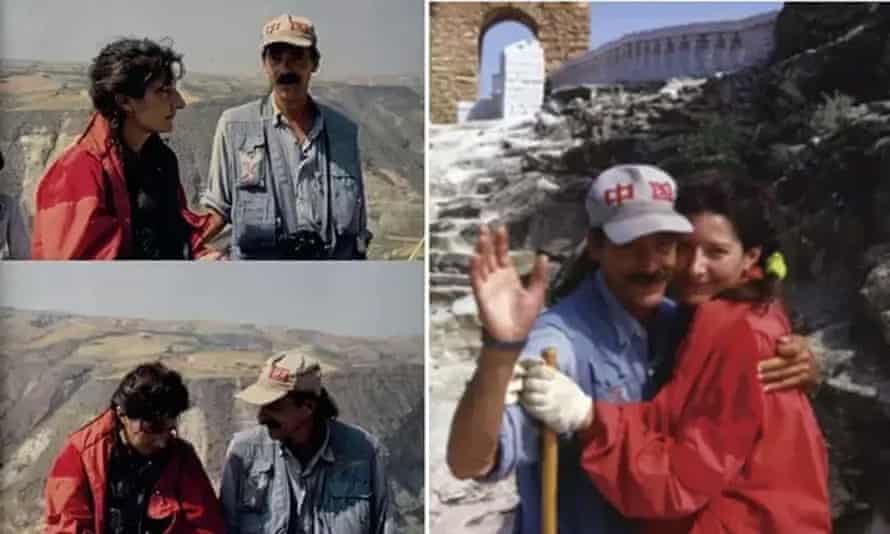
To the Chinese, the dragon is an auspicious symbol, representing force, adept fortune and the elemental forces of nature. Walking the dragon's spine had, for Ulay and Abramović, been intended every bit a great motif for transcending the barriers that dissever us – it was to be a totem of love and reconnection. Instead, the wall came to represent a division in myriad forms, not just physical just also the political barriers they then perceived between east and west, as well as the emotional barriers that had grown between the pair. Since planning to walk the wall, their differences had become more apparent and more hard to reconcile. Abramović embraced the growing success of their work; Ulay withdrew from it.
Unlike in China, the dragon in western mythology is perceived as a symbol of malevolence, a subversive fauna to be hunted down and destroyed. Abramović claimed that the idea for The Lovers came to her in a dream, a vision in which the pair would wake a sleeping dragon through their epic walk. They had, it seemed, woken the wrong dragon.
Over the adjacent two decades, Abramović's work connected to reach larger and larger audiences; her glory grew. Her work inspired Lady Gaga and Jay-Z, she made adverts for Adidas and she came to exist known as "the grandmother of operation art".

In 2010, at a New York Museum of Modern Fine art retrospective of her piece of work entitled The Artist Is Present, Abramović sat for eight hours a day – 750 hours in total – in silence, at a tabular array. Members of the public were invited to come, sit down and hold her gaze. They were kept 2 metres apart at opposite ends of a table. Contact was not permitted. The prove was spiritual and cathartic for some, pretentious and self-indulgent to others. Many queued for hours for the opportunity to sit opposite Abramović for a few minutes or, in a few cases – and to the irritation of those in the queue – the whole day.
Ane moment, however, was to capture the world'due south attending and amass close to xx million views on YouTube. On the opening dark of the show, Ulay made a surprise advent, steppping from the audience to sit and face his quondam lover. He nervously stretches his legs, adjusts his jacket and, equally Abramović opens her optics to see him, the pair smiling. Information technology is the first time in 22 years that they have seen each other. Tears fill their eyes.
Finally Abramović, in a flowing blood-blood-red apparel, leans beyond the ii-metre division and – breaking her ain rule of not-contact – takes Ulay's easily. Onlookers brainstorm to applaud. It is impossible to watch this moment without likewise being moved to tears. Afterward their backbreaking journey and a long time autonomously, they are finally reunited. A new dragon is awakened. Intimacy is rekindled.
While their separation was a choice, ours – for now – remains a necessity. In fourth dimension, physical intimacy volition return to united states of america all. And with it, perhaps, the opportunity for us all to awaken a new dragon.
Source: https://www.theguardian.com/travel/2020/apr/25/marina-abramovic-ulay-walk-the-great-wall-of-china
0 Response to "Depictions of the Great Wall of China in Art"
Post a Comment